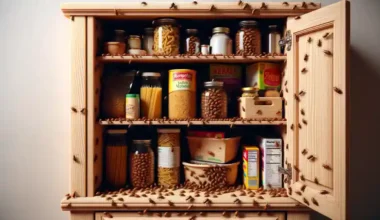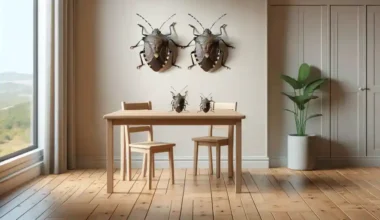Bed bug treatment can be a lengthy process that may take several weeks to months, depending on the severity of the infestation. As such, you want to cut costs and get rid of bed bugs on a tight budget. Factors such as the number of bed bugs present, the amount of clutter providing hiding places, neighboring infestations, and the level of cooperation from all residents can greatly impact your outcome.
How to get rid of bed bugs on a tight budget

To achieve the best results, everyone in the household needs to work together to exterminate bed bugs. Here are the steps to get rid of bed bugs on a tight budget:
- Identify the infestation
- Formulate a comprehensive plan
- Contain the spread of the bed bugs
- Prepare your home for treatment
- Eliminate all bed bugs
- Assess the situation and implement preventative measures
Note: You may need to repeat these steps multiple times to completely eliminate all bed bugs.
1. Identify the infestation
Gather a sample to show to an extension agent or insect expert. These professionals are trained in pest control and knowledgeable about the local area, and they can identify the pest at no charge to you.
If the pest is confirmed to be bed bugs, it is important to notify your landlord if you live in a rented apartment. Other units in the vicinity should also be inspected as well.
Landlords may be legally obligated to participate in the bed bug treatment process, so check the housing codes and laws in your area.
To determine the extent of the infestation, inspect all areas that may be affected by bed bugs, as well as the surrounding living spaces. This will give you a better understanding of the situation and help you to plan your next steps to get rid of bed bugs on a tight budget.
2. Formulate a comprehensive plan
Create a timeline for carrying out the following steps, taking into account any personal plans such as vacations.
Maintain a comprehensive record throughout the entire process. Make note of the dates and specific locations where pests are discovered. This will aid in monitoring your progress and determine more effectively where to focus your efforts.
After completing the treatment, continue to check for bed bugs for at least one year to ensure that all pests have been eliminated.
3. Contain the spread of the bed bugs
Eliminate small hiding spots by sealing them with silicon caulk. This will remove potential hiding places and force the bed bugs into the open.
Dispose of infested items by placing them in a sealed plastic bag and treating them with appropriate methods, as outlined in the following sections. Items that cannot be treated should be stored in a sealed plastic bag or container for up to a year to ensure that all live bed bugs have died.
Invest in protective covers for your mattresses and box springs that seal completely, trapping and killing the bed bugs.
Also, vacuum regularly and dispose of the bags immediately after each use in an outdoor trash container, making sure to seal the bag tightly.
If you are unable to safely eliminate bed bugs from furniture, consider disposing of them. This can be done by ripping covers and removing stuffing, marking the furniture with “Bed Bugs” using spray paint, and having it picked up promptly by the waste collection agency. Avoid discarding furniture such as your couch if it is possible to safely eliminate the bed bugs from it.
4. Prepare your home for treatment
Proper preparation before treatment is crucial as it will facilitate the monitoring of bed bugs that may have survived the extermination process.
This preparation is necessary regardless of whether you are handling the treatment yourself or hiring a professional.
5. Eliminate all bed bugs
Ensure that the methods you choose to get rid of bed bugs on a tight budget are safe, effective, and compliant with the law. Just avoid treatments that are ineffective just because you are on a tight budget.
Note the following:
- Substances such as rubbing alcohol, kerosene, and gasoline can be hazardous to you and your family and pose a fire risk from sparks or cigarettes.
- Sticky traps are not effective against bed bugs and rodents such as mice, but they may be useful in capturing spiders, and cockroaches.
Consider using non-chemical methods to eliminate bed bugs. The effectiveness of these methods may vary depending on your specific circumstances. While these and other methods can be useful, they may not completely eradicate the infestation. Below are non-chemical treatment methods to get rid of bed bugs on a tight budget:
a. Heat treatment
You can use a clothes dryer on high heat or place items in black plastic bags in a hot car in the sun. However, the success of this method is dependent on your climate and other factors, and DIY heat treatments may not be effective.
Professional extermination services have access to more intensive and proven methods, including heat treatments for entire homes. It is dangerous and ineffective to try to kill bed bugs by increasing indoor temperatures using a thermostat, propane space heater, or fireplace.
b. Cold treatment
Although this method may work, it can only be successful in a household setting if the freezer is set to 0°F. Also, the things you are freezing must be left in the freezer for at least 4 days to get rid of bed bugs on a tight budget.
Most home refrigerators and freezers do not reach low enough temperatures to kill bed bugs. To use this method, items must be placed in a sealed bag in the freezer for a minimum of three days at 0°F. Use a thermometer to verify the temperature as home freezers may not always be set to 0°F.
c. Steam cleaning
Both wet and dry steam cleaners can reach cracks and fabrics to treat carpets, baseboards, bed frames, and furniture. The steam temperature must be at least 130°F, but it should not have a strong airflow, as this could cause the bed bugs to scatter. Use a diffuser to prevent scattering.
d. Pesticides
If necessary, use pesticides with caution, following the instructions on the label:
- Search for pesticides that are registered with the Environmental Protection Agency (EPA) and specifically mention bed bugs on the label.
- Use foggers (bug bombs) with extreme caution and only if bed bugs are mentioned on the label. Improper use can pose a threat to your health and may result in a fire or explosion. Foggers should not be relied upon as the sole method of bed bug control as the spray will not reach the hidden cracks and crevices where bed bugs reside.
Now, you want to inspect your home for any signs of bed bugs in the days following the initial cleanup and control process. If you observe bed bugs, it is possible that some were missed during the initial cleanup or that eggs have hatched. Further treatment may be necessary in these cases.
If repeated treatments are required, consider using different types of pesticides to eliminate bed bugs.
e. Bed bug chemicals
Desiccants are chemicals that cause drying and can be an effective solution in certain circumstances as they work by dehydrating the bed bugs, making it difficult for them to develop resistance.
However, it may take several months for the desiccants to work to get rid of bed bugs on a tight budget. When using desiccants, ensure that you use only EPA-registered pesticide products.
Avoid using a pool or food-grade diatomaceous earth. This type of diatomaceous earth, which is derived from the fossilized remains of small aquatic organisms known as diatoms, can be harmful if inhaled. The pesticide version uses a different size of diatoms, which reduces the risk.
f. Use Bed bug interceptors
Bed bug interceptor traps can be placed under the legs of furniture to capture bed bugs and prevent them from climbing up the legs. Both commercial and homemade interceptor traps are available options.
You can create your own interceptor traps. To create your own bed bug interceptor traps, do the following:
i. Collect the necessary supplies
- You need 2 clean plastic containers (one container should fit inside the other and both should have sturdy, tall sides of over 1 inch). Cleaned and reused deli or take-out food containers are a suitable choice.
- Masking or painter’s tape with a rough surface.
- Talcum powder.
ii. create a bed bug interceptor trap
- Ensure that the small container is large enough to fit a bed or couch leg inside.
- Apply masking tape to the exterior of the larger container to allow bed bugs to easily climb into the container.
- Secure the two containers together by gluing or taping them, with the smaller container placed inside the larger one.
- Sprinkle a small amount of talcum powder into the bottom of both containers. The talcum powder will make it slippery and prevent the bed bugs from escaping.
- Create enough interceptor traps to place under each leg of the infested furniture, such as beds, couches, or chairs.
- If necessary, move the furniture a few inches away from the walls and ensure that no linens are touching the floor, only the furniture legs.
- Inspect and clean the interceptors weekly, reapplying talcum powder as needed.
- Dispose of captured bed bugs by placing them in a sealed plastic zip-type or sealable bag.
6. Assess the situation and implement preventative measures
Finally, conduct regular inspections for bed bugs in your home, including checking the interceptor traps if applicable, at least once every 7 days to detect and eliminate any surviving eggs.






